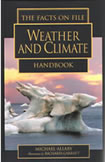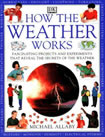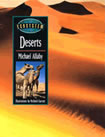Discovering the Earth
Facts On File, Inc., New York.
| Earth Science | Animals | Exploration |
| Atmosphere | Ecology | |
| Oceans | Plants |
 |
|
| Read more about this book | |
The natural environment includes the ground beneath our feet, the air we breathe, the oceans, and the plants and animals with which we share our world. The scientists who study the environment approach it from many directions. There are geologists, geomorphologists, oceanographers, climatologists, meteorologists, ecologists, botanists, zoologists, and many more. Each works within a particular scientific discipline, but because each of them is investigating an aspect of the environment, all of them are environmental scientists and their specialist disciplines are branches of the environmental sciences.
These seven books describe how, over the centuries, scientists have observed and investigated the world around them and its living inhabitants, and how their work has contributed to the growth and development of the environmental sciences. There are many stories to tell. Some happened only recently, within the last few decades. Others are thousands of years old, and some, comprising observations that became folklore, took place before people kept written records. And as well as stories about discoveries, each book contains short accounts of the lives of some of the scientists who made them.
 |
|
| Read more about this book | |
Discovering the Earth begins with Earth Science: A Scientific History pf the Solid Earth. It describes how scholars, explorers, and mapmakers measured the Earth and mapped its surface. It tells of their speculations about what lies beneath the surface, how mountains rise and ocean basins fill. It explains how scientists came to understand the meaning of fossils, how they discovered the age of the planet, and, more recently, how the theories of seafloor spreading, continental drift, and plate tectonics developed.
Atmosphere: A Scientific History of Air, Weather, and Climate describes how scientists, beginning in ancient Greece, have slowly unraveled the chemical composition of air and the physical laws that regulate its behavior. It tells of the instrument makers who invented the equipment that allowed them to measure the state of the air, the balloonists who first explored the upper atmosphere, and of the growth in understanding of weather phenomena and their causes.
 |
|
| Read more about this book | |
 |
|
 |
|
| Read more about this book | |
 |
|
Oceans: Marine Science begins by describing how the ocean surfaces were mapped, and how surveyors sailed around the continents meticulously measuring coastlines. It continues by outlining the theories with which scientists sought to explain the origin of the oceans, and of the early explorations of the ocean floor. It describes some of the animals that live in the deepest parts of the ocean, where it is perpetually dark and intensely cold. The book also describes sea monsters, some imaginary and others real.
Animals: From Mythology to Zoology begins with an outline of early ideas about the nature and origin of animals. Rulers in the ancient world kept collections of animals to impress their visitors and demonstrate their power. The book describes some of these collections in China, Mesopotamia, Egypt, Greece, and Rome and tells how they developed from menageries to modern zoos. People have always drawn lessons from the behavior of animals and the book describes a number of real animals and the “characters” they were once supposed to possess. It is but short step from there to list of fantastic beasts that writers heard about from sailors and other visitors to distant regions of the world, and as well as fantastic animals there were also fantastic humans. From there the book returns to reality and descriptions of the growth of modern zoology and animal classification, and of ethology the study of animal behavior.
Ecology: Plants, Animals, Environment begins with an account of an English clergyman and a book about the plants, animals, people, and seasons in his parish that became one of the earliest books on ecology but written many years before that term was first used. It tells of the beginning of conservation and of the classification of organisms. That led to a rise in interest in the geographical distribution of plants and animals. The study of animal and plant communities began in the 19th century and it was then that it came to be called “ecology.” The book describes the differing American and British approaches to ecological studies, and it ends by distinguishing between ecology and environmentalism.
Plants: Foods, Medicines, and the Green Earth tells of the birth of botany in ancient Greece and the medicinal uses of plants. Medicinal plants were cultivated in gardens, and the book describes some of these, and how they eventually became botanical gardens. Medicinal plants were also described in books that in time came to include plants with no therapeutic uses. Listing plants revealed the need for a coherent system of classification and the book outlines the development of the system used today. The book tells of some of the plant hunters who traveled the world collecting specimen plants that were returned to Europe and America, where they were cultivated. It describes discoveries leading to an understanding of the origin and evolution of plants, and of their physical structure. The book ends with the story of how plants came to be studies as communities plant ecology and sociology and with the modern recognition of the importance of conservation.
‘Everything you’ve always wanted to know about plants is packed into this beautifully illustrated and easy-to-read set of books.’
Library Talk, May/June 2001
‘Does a fine job of introducing complex topics.’
Reference Books Bulletin, July 2001
‘The richness of our diversified plant world is explored in basic terms. … Although the set is geared for middle- and junior-high-school students, high schools might also wish to purchase it for its broad introduction to the complex principles of botany.’
Booklist, July 2001
 |
|
Exploration: New Lands, New Worlds is the last book in the series, but without the story of how people ventured forth, taking their lives in their hands, to explore every last corner of the planet, none of the environmental sciences could have developed. This book tells of the explorers by land and sea, and finally of the first steps away from Earth in search of new worlds. The book also explains why humans have always needed to explore, and why they still do.





























